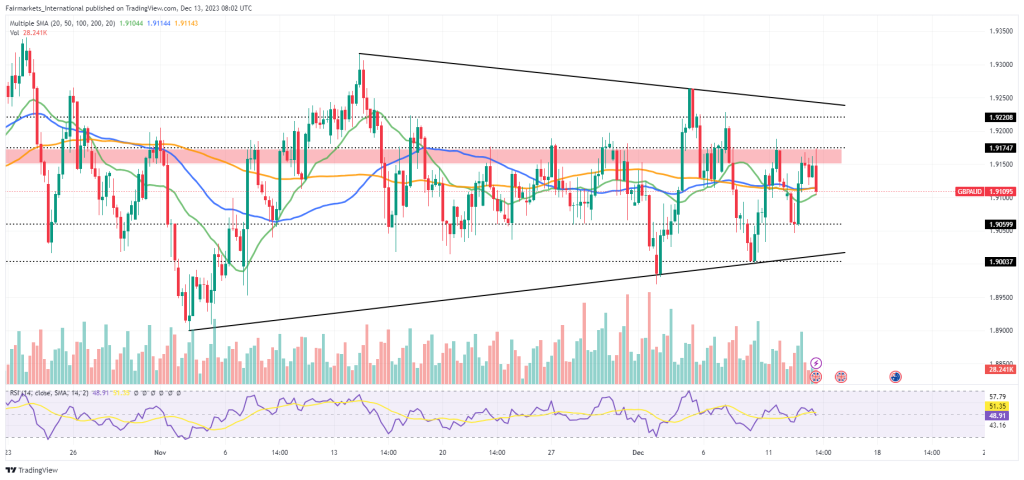
The GBPAUD pair faces a nuanced trajectory influenced by divergent economic performances. The recent contraction in the UK’s GDP by 0.3% in October, coupled with weaker-than-expected job data, reflects economic struggles, amplifying speculation of potential BoE interest rate cuts. Conversely, TD Securities’ forecast favours the Australian Dollar, foreseeing a robust 2024 owing to China’s stimulus-driven growth.
Amidst the UK’s service sector contraction, including notable declines in information and communication, coupled with production and construction setbacks, the Pound is under strain. Conversely, the Australian Dollar benefits from expectations of a recovering Chinese economy, less aggressive rate hikes by the Reserve Bank of Australia, and a global risk-on sentiment.
Technical Analysis:
The GBPAUD pair is currently at 1.91095, with the price action lower following the rejection of the supply zone higher. Trading around key SMAs – 20-SMA (green line), 50-SMA (blue line), and 100-SMA (orange line) – indicates a neutral stance. The convergence of the 20-SMA with the 50-SMA and 100-SMA denotes a potential consolidation.
RSI at 48.91 signifies a flat momentum. Short-term trading opportunities may emerge if the price sustains a push below SMAs, targeting initial support at 1.90599. Further downward momentum could bring the 1.90037 support level into play. Conversely, sustained support from the SMAs might trigger a move towards the 1.91747 resistance level, potentially validating bullish momentum towards 1.92208.

Summary:
GBPAUD faces a pivotal juncture. The UK’s economic woes may pressure the Pound, potentially leading to BoE rate cut speculation. Conversely, Australia’s positive growth outlook might sustain the Australian Dollar.
The technical outlook hints at potential short-term movements, with support at 1.90599 and resistance at 1.91747 as key levels to watch, dictating potential trading opportunities. The pair’s direction will likely pivot on economic releases and central bank decisions, especially the Fed’s and BoE’s forward guidance, shaping market sentiment and influencing the Pound-Aussie dynamics.
Sources: TradingView, Trading Economics, Reuters, Dow Jones Newswire, MT Newswire.
Piece written by Mfanafuthi Mhlongo, Trive Financial Market Analyst
Disclaimer: Trive South Africa (Pty) Ltd, Registration number 2005/011130/07, and an Authorised Financial Services Provider in terms of the Financial Advisory and Intermediary Services Act 2002 (FSP No. 27231). Any analysis/data/opinion contained herein are for informational purposes only and should not be considered advice or a recommendation to invest in any security. The content herein was created using proprietary strategies based on parameters that may include price, time, economic events, liquidity, risk, and macro and cyclical analysis. Securities involve a degree of risk and are volatile instruments. Market and economic conditions are subject to sudden change, which may have a material impact on the outcome of financial instruments and may not be suitable for all investors. When trading or investing in securities or alternative products, the value of the product can increase or decrease meaning your investment can increase or decrease in value. Past performance is not an indication of future performance. Trive South Africa (Pty) Ltd, and its employees assume no liability for any loss or damage (direct, indirect, consequential, or inconsequential) that may be suffered from using or relying on the information contained herein. Please consider the risks involved before you trade or invest.




